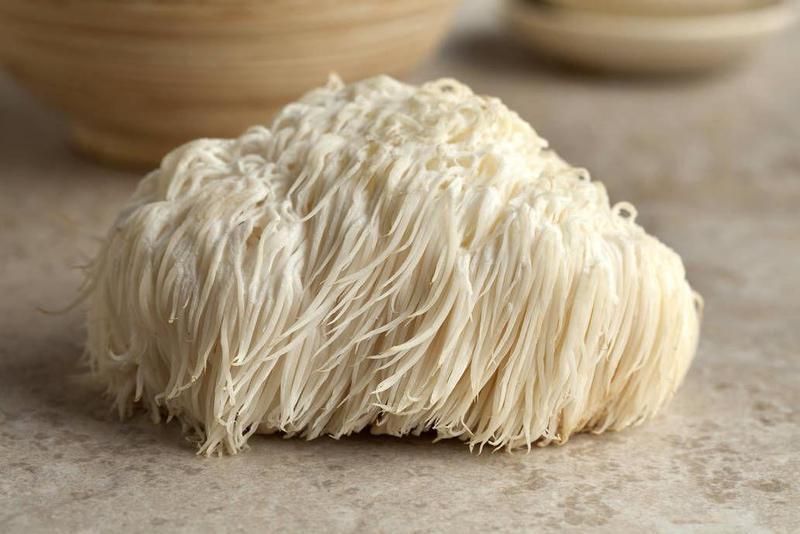This Delicious Mushroom Will Prevent Alzheimer’s DiseaseMar 29, 2018

Have you ever lost your keys or forgotten what you were saying mid-sentence? Humans tend to be slightly forgetful. This delicious mushroom will help improve your mood, memory, and much more!
Lion’s mane, also known as Hericium erinaceus, is an edible and medicinal mushroom that belongs to the tooth fungus group. It is native to North America, Europe, and Asia. These mushrooms are commonly found growing on hardwoods, particularly American Beech, and have a tendency to grow in clumps. In the wild, they are normally found during late summer and fall.
Unlike the classic looking cap-and-stem variety of mushrooms, lion’s mane can be identified by its unique globular-shaped, cascading teeth-like spines. Spores emerge from these teeth-like tendrils, allowing it to reproduce. Lion’s mane has a delicious taste that is similar to lobster or shrimp. It is sold in many gourmet food chains. This nutritious fungus is roughly 20 percent protein, making it a great meat substitute. An easy and delicious way to cook lion’s mane is by slicing the mushrooms up and adding them to a pan with salted butter, crushed garlic, and white pepper. You will know that they are ready once they are slightly crispy along the edges.
Lion’s mane has been used in China for centuries as a brain tonic and as a treatment for many health conditions. This mushroom can boost immune strength, helping to fight off sickness. Containing beta-glucan polysaccharides, polypeptides, and fatty acids, lion’s mane can also help digestive and colon health. Lion’s mane is also helpful in treating anxiety and depression. A study of thirty menopausal women, published in 2010 in Biomedical Research, showed that the subjects receiving Lion’s mane were less anxious and irritable, allowing them to concentrate easier. According to a study reported by Burton Goldberg in “Heart Disease”, lion’s mane substantially reduced the blood pressure of every subject involved.
Most importantly, lion’s mane is extremely good for the brain. Studies have shown that this mushroom can stimulate the synthesis of (NGF) Nerve Growth Factor. NGF allows for nerve cell survival in the nervous system. A lack of NGF can contribute to health conditions such as dementia and Alzheimer’s disease. This protein cannot pass through the blood-brain barrier, and therefore an injection of NGF will not work. This is why lion’s mane is so useful in the treatment of these brain diseases. Due to its low molecular weight, the nerve regenerating compounds in the fungus are able to pass the blood-brain barrier. This allows it to stimulate and repair nerve cells in the brain, increasing cognitive function. In one study published by Phytotherapy Research in 2009, researchers assigned lion’s mane extract or a placebo to thirty older adults with slight cognitive impairment every day for sixteen weeks. In cognitive tests given at weeks eight, twelve, and sixteen, members of the lion’s mane group showed significantly greater improvements compared to members of the placebo group.
As more and more people suffer from Alzheimer’s and other diseases related to neurodegeneration, it is important to try to find preventative cures that are natural and safe. Lion’s mane is a relatively inexpensive, easily cultivated fungal food that proves to be therapeutic in many ways. Not only is lion’s mane a tasty and nutritious meat substitute, it is also a memory enhancer and an antidepressant. You can find lion’s mane in some health food stores, and online. Or you can grow your own with simple grow kits.
Lion’s mane can be used to:
Strengthen immune system
Improve cognitive function
Treat anxiety
Treat depression
Treat high cholesterol
Stimulate synthesis of (NGF) Nerve Growth Factor
Treat cancer
For antioxidant effect
Treat arthritis
Regulate blood pressure
Treat inflammation
Treat dementia
Increase intelligence
Improve reflexes
Fight infections
Promote longevity
Treat Parkinson’s disease
Rejuvenate nerve growth
Promote a healthy digestive system
Regulate blood sugar levels
Treat Alzheimer’s disease
Eliminate toxins in the body
Treat ulcers
Treat arthritis
Improve memory
Here is a simple five-step guide to growing your own lion’s mane:
What you will need:
4 to 5 foot long log
Chain saw
Power drill
Mushroom spawn plugs
Rubber mallet
Beeswax
Foam craft brush
Step 1: Cut a log that measures between 12 to 16 inches in diameter. You can cut more than one log depending on the amount of mushrooms you intend to grow.
Step 2: Drill holes into your log(s) using a power drill and 5⁄16-inch drill bit. The holes should be drilled 2 and 4 inches in depth and 3 to 5 inches apart. Drill the holes in an oval or diamond shaped pattern. Repeat this process as many times as possible on the upward face and sides of the log(s). Make sure not to add any to the bottom.
Step 3: Place the mushroom spawn plug(s) into each drilled hole by use of the rubber mallet. Make sure to only use mushroom spawn plugs for this part. You can purchase them from a garden store or an online mushroom supplier.
Step 4: Heat beeswax until it has melted into a liquid state. Brush the melted beeswax over each inserted mushroom spawn plug using your foam craft brush. The beeswax coating will protect the mushroom spawn plug(s) from weather, insects, parasites, and other things that could impact mushroom growth negatively.
Step 5:
Place the logs you have inoculated in a damp, shady area. These conditions will allow the mushrooms to sprout and grow in their natural environment.
Be the first to post a message!